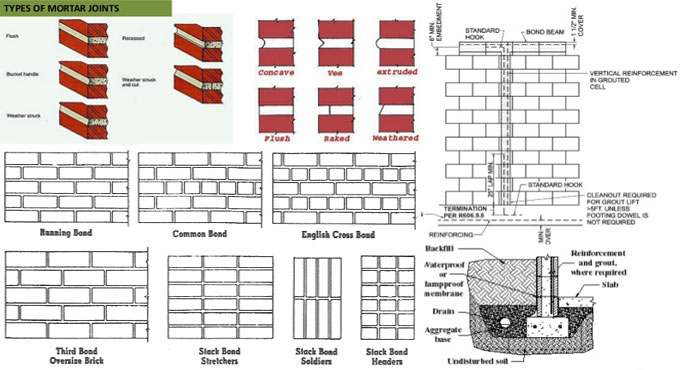Mortar is extended in among the masonry, grouts, and stuffs the cavities of the masonry units. Mortar belongs to the material that is visible among the bricks. Mortar allows the masonry units to remain jointly. Mortar is very vital in masonry construction. It is always recommended to apply the proper mortar or grout.
The process is complicated to find out the exact mixture for the mortar or grout for maintaining proper strength. The mortar or grout should contain the perfect strength to get rid of over bearing issue (load bearing in this case). Besides, the mixture that retains the masonry sections together should not be considerably stronger that what the masonry units are, because it can transform the load bearing to gain extreme amount of stress.
If the mortar’s mixture is not provided properly it can lead to weighing over the masonry units themselves and results in damaging the structure with cracking and/or spakling.
The categorization is done on the basis of ASTM C 270 (Standard Specification for Mortar for Unit Masonry). Given below, various categories of mortar.
Mortar-Type M: Mortar (Type M) contains a minimum 2500 psi and suitable for areas to withstand a considerable amount of load bearing, wind forces, earthquakes, and etc. This specific type of mortar is normally applied with stone. If the Mortar is formed with any material that contains less strength, it may collapse the structure and its job positioning prematurely.
Application - This type of mortar is normally applied with stone as it closely simulates the strength of stone, it will not collapse prior to the stone itself collapses.
Mortar (Type S): This type of mortar contains a minimum of 1800 psi. It contains medium strength, and defined as (Type S). It is mostly utilized for outside structures like a patio as well as exterior walls which are assessed below grade as it is more durable as compared to (type N). Therefore, it is best suited to perform with mildly withstanding soil pressures below grade.
Applications - Below grade having normal to moderate loading. In some areas where the masonry touches the ground, like paving or shallow retaining walls.
Mortar (Type N) for general purposes: Mortar (Type N) is mostly recognized mortar. This type of mortar is utilized when there exist no other special circumstances which need a specialty for the load bearing of a structure. It has medium strength (minimum 750 psi) and is suitable for reinforced interior and above-grade exterior load-bearing walls. It is perfect for semi-soft stone or masonry as it will bend in excess of a high-strength mortar to resist prevents cracking of the masonry units.
Mortar (Type O): Mortar (Type O) refers to a mortar that contains a low strength (a minimum of 350 psi). This type of mortar is useful for interior usages where non-load bearing exist. It is frequently applied to patch mortar where the wall has strong structure. Type O mortar is occasionally applied with masonry units having a low compressive strength (i.e. sandstone or brownstone) to allow more flexibility for resisting cracks in the units.
Applications: Interior non-load-bearing areas with very restricted exterior use because of its low structural capacity and not suitable for the areas prone to high winds. Type O Mortar mix is perfect when repointing because of its stability. It is applied in above grade, non-load bearing situations preferably in interior environments.
Mortar (Type K): The (Type K) Mortar is not listed under the ASTM C 270 anymore, although it is still applicable to projects which have a pre-historic preservation need. This type of mortar will not produce any damage to a fragile structure, nor to any fragile stones as it contains the lowest compressive strength of any mortar.
Applications : Mortar (Type K) is useful for safeguarding pre-historic structures, which needs the use of a low strength mortar to get rid of any damage. Type K is not recommended for load bearing.

No comments:
Post a Comment